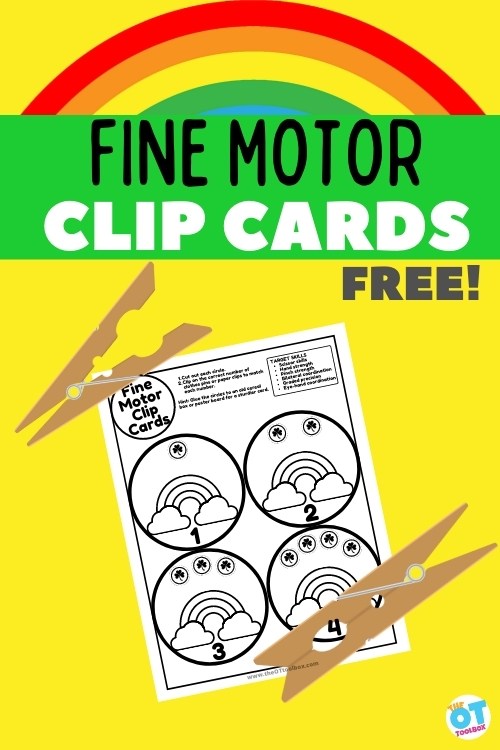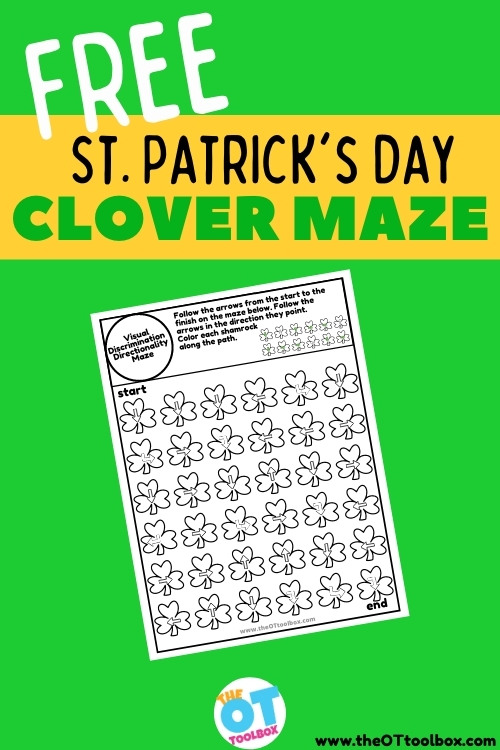Today on the site we’ve got a great Shamrock activity…Fine motor clip cards with a shamrock theme! This is a great addition to St. Patrick’s Day activities in therapy, home or the classroom, and they work on a ton of different skills. Print them off, laminate the clip cards if you like, and you have a literal therapy pot of gold!

This week as we roll out these fabulous Shamrock Activity (Fine Motor Clip Cards), let us take a moment to be thankful the weather is warming up and we can finally celebrate spring. If you are not fortunate enough to have spring weather yet, I feel for you.
According to the news report, people are moving out of California, New Jersey and New York in droves. I am surprised more of y’all from Wisconsin and North Dakota aren’t rustling out of there too! No matter what the temperature is outside, this cute Shamrock Activity Fine Motor Clip Card spring themed activity will help get you motivated for warmer weather.
Shamrock activity for Fine Motor skills
There is something magical about rainbows and unicorns. Throw some shamrocks in there for good luck, and it is the perfect spring trifecta!
Add them to these other shamrock and St. Patrick’s Day themed activities that support the development of fine motor skills:
These Shamrock Activity fine motor clip cards are so versatile, they will be able to be modified for most, if not all of your learners. Read below for ways to adapt and modify this fine motor activity.
How to use this shamrock activity:
- Have learners count the number of shamrocks and place a mark to designate the number of items on the card. These cards would be great with a (Amazon affiliate link) Dot or Bingo marker!
- Learners can color in the rainbows as they go
- Cut these ahead of time, or make cutting a part of this fine motor counting clip activity
- Use clothespins to attach to the shamrock cards to count the numbers. Decorated clothespins are even more fun! They are great spray painted gold, or dipped in glitter
- Color and laminate these cards for reusable fun. Learners can use dry erase markers to count the objects
- Enlarge or shrink this page to change the level of difficulty
- Change the type of paper, heavier weight is easier to handle, but may be harder to cut
- Colored paper might be more motivating, or provide better contrast
- Project this onto a smart board to make it a touch task, or have students follow along with the diagram
- Scatter the cards around the room to include a gross motor component
- Add these cards to an obstacle course having learners complete the challenge, collecting clips along the way
- Scavenger hunt to have learners find all of the cards in order
- Crab walk from one card to the next
- Create an entire St. Patrick’s Day theme for the week!
- Add spring fine motor tasks with this great fine motor bundle found on the OT Toolbox
- The possibilities are really endless, don’t let yourself get stuck doing this fine motor activity just one way
Things to Observe with these Shamrock Activity Clip Cards
When working on this shamrock fine motor activity, there are several observations that can be made:
- Can your learner scan the page and count all of the shamrocks?
- How many items can your learner correctly count?
- Does your learner correctly hold and manipulate the scissors, crayon, or bingo marker? How much assistance do they need to grip scissors, cut the paper, or color the rainbow?
- Do your learners have the strength to open and place the clothespins?
- Can your student motor plan all of the skills needed for this task?
- Will you need to modify this activity for success?
- Can your student continue to hold the clothespins while trying to manipulate the paper?
- What is the number of times you need to repeat the directions so your learner can follow them?
- How many reminders does your learner need while doing this activity?
Use these notations in your documentation to document data and support the development of fine motor skills.
what skills do my learners need?
While cutting, coloring, counting, and placing clips is a straightforward task for higher level learners, beginners will struggle with all of the parts needed to complete this task.
Think about all that has to be involved to do this counting shamrock activity:
- Fine motor skills – Resources can be found in our fine motor skills library at the OT Toolbox
- Strength
- Bilateral coordination
- Visual perception
- Executive function/behavior/social skills
- Following directions
- Attention to detail
- Work tolerance
- Cutting on a line
- Coloring
- Counting
- Multistep directions
- Processing skills
This is just the start of the list when using these Shamrock fine motor clip cards!
Perhaps focus your attention on addressing, or observing, just one or two of these skills. For example, work on following directions or counting, rather than all of them.
Need more great Shamrock and St. Patrick’s Day tools?
Here are a few more spring activities and ideas from the OT Toolbox to get you started. Round out your shamrock theme with this new Color Handwriting Kit with Bonus Rainbow Sheets!
While spring is a lovely change of pace from winter, summer is really my jam! Bring on the heat!
Free Shamrock Printable Clip Cards
Want to add this resource to your therapy toolbox so you can help kids thrive? Enter your email into the form below to access this printable tool.
This resource is just one of the many tools available in The OT Toolbox Member’s Club. Each month, members get instant access to downloadable activities, handouts, worksheets, and printable tools to support development. Members can log into their dashboard and access all of our free downloads in one place. Plus, you’ll find exclusive materials and premium level materials.
Level 1 members gain instant access to all of the downloads available on the site, without enter your email each time PLUS exclusive new resources each month.
Level 2 members get access to all of our downloads, exclusive new resources each month, PLUS additional, premium content each month: therapy kits, screening tools, games, therapy packets, and much more. AND, level 2 members get ad-free content across the entire OT Toolbox website.
Join the Member’s Club today!

Victoria Wood, OTR/L is a contributor to The OT Toolbox and has been providing Occupational Therapy treatment in pediatrics for more than 25 years. She has practiced in hospital settings (inpatient, outpatient, NICU, PICU), school systems, and outpatient clinics in several states. She has treated hundreds of children with various sensory processing dysfunction in the areas of behavior, gross/fine motor skills, social skills and self-care. Ms. Wood has also been a featured speaker at seminars, webinars, and school staff development training. She is the author of Seeing your Home and Community with Sensory Eyes.
- NOTE: The term, “learner” is used throughout this post for consistency. This information is relevant for students, patients, clients, school aged children/kids of all ages and stages, or whomever could benefit from these resources. The term “they” is used instead of he/she to be inclusive.



